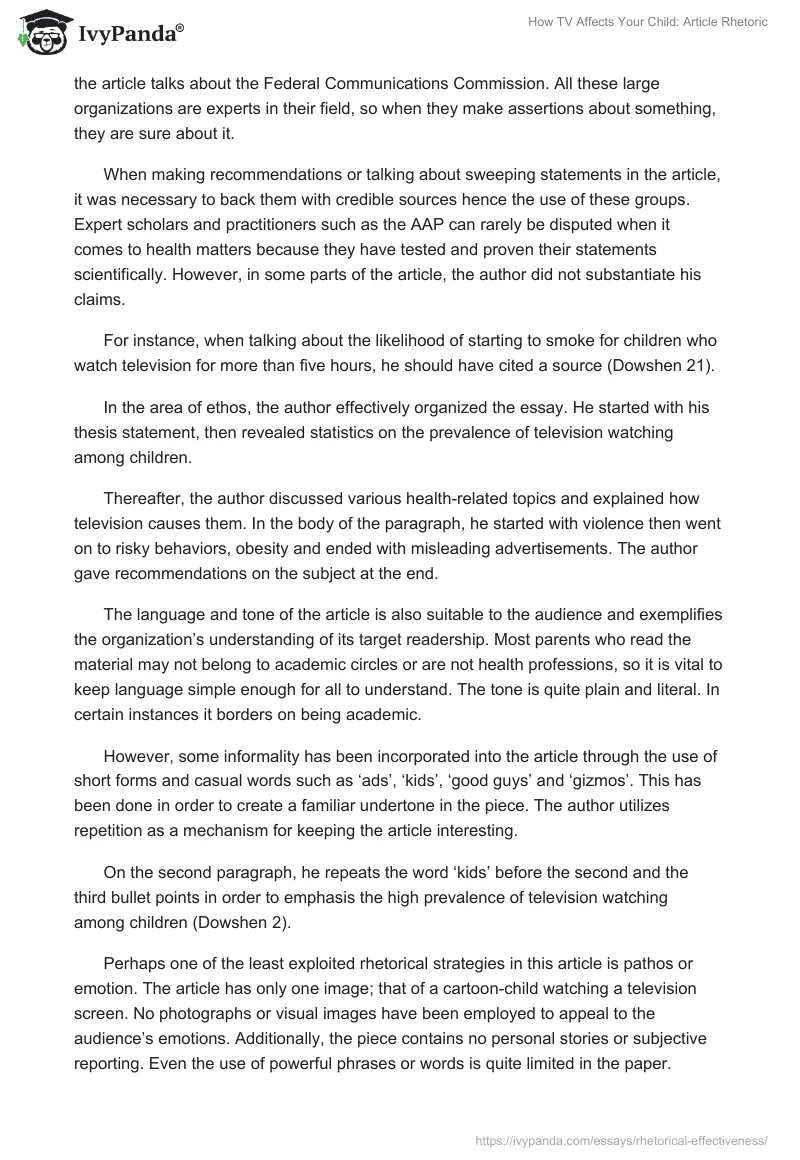Steven Dowshen’s “How TV affects your child” is an article designed to enlighten parents about a social issue that can alter their children’s health.
In this article, the author sensitizes parents about the likelihood of coping with obese, aggressive and drug-dependent (alcohol and cigarettes) children due to too much television-watching. Ethos and pathos are some of the techniques that the writer uses in order to make a believable case against television watching in children.
The first part of the article uses logos as a rhetorical strategy. The author probably wanted to establish that the article is factual and formal. One cannot find any mention of personal stories throughout this essay because the creator wanted to prove that the subject matter was serious. As such, the writer’s first and second paragraphs contain startling statistics about the number of children that watch television in the country.
These are details that emanate from objective health research, so one can be fully convinced that the assertions are true. In subsequent portions of the essay, the author uses cause and effect in order to validate his arguments. For instance, he explains that television leads to violence because no one is punished for their violent behavior; even the heroes are violent.
The author views the promotion of violence on television as a cause of desensitization towards aggression and violence among children. The effect of this desensitization is violence (Dowshen 7). Conclusions are carefully linked to their logical causes thus strengthening the author’s case.
Ethos has been employed in the article in order to convince the audience that the writer is credible. At the beginning of the essay, the author cites the Kaiser Family foundation and then also mentions the American Academy of pediatrics (AAP) when recommending the amount of television exposure that children should have.
Later on, the author mentions the Center on Alcohol Marketing and Youth when quoting statistics on the exposure of youth to alcohol advertisements. Towards the end, the article talks about the Federal Communications Commission. All these large organizations are experts in their field, so when they make assertions about something, they are sure about it.
When making recommendations or talking about sweeping statements in the article, it was necessary to back them with credible sources hence the use of these groups. Expert scholars and practitioners such as the AAP can rarely be disputed when it comes to health matters because they have tested and proven their statements scientifically. However, in some parts of the article, the author did not substantiate his claims.
For instance, when talking about the likelihood of starting to smoke for children who watch television for more than five hours, he should have cited a source (Dowshen 21).
In the area of ethos, the author effectively organized the essay. He started with his thesis statement, then revealed statistics on the prevalence of television watching among children.
Thereafter, the author discussed various health-related topics and explained how television causes them. In the body of the paragraph, he started with violence then went on to risky behaviors, obesity and ended with misleading advertisements. The author gave recommendations on the subject at the end.
The language and tone of the article is also suitable to the audience and exemplifies the organization’s understanding of its target readership. Most parents who read the material may not belong to academic circles or are not health professions, so it is vital to keep language simple enough for all to understand. The tone is quite plain and literal. In certain instances it borders on being academic.
However, some informality has been incorporated into the article through the use of short forms and casual words such as ‘ads’, ‘kids’, ‘good guys’ and ‘gizmos’. This has been done in order to create a familiar undertone in the piece. The author utilizes repetition as a mechanism for keeping the article interesting.
On the second paragraph, he repeats the word ‘kids’ before the second and the third bullet points in order to emphasis the high prevalence of television watching among children (Dowshen 2).
Perhaps one of the least exploited rhetorical strategies in this article is pathos or emotion. The article has only one image; that of a cartoon-child watching a television screen. No photographs or visual images have been employed to appeal to the audience’s emotions. Additionally, the piece contains no personal stories or subjective reporting. Even the use of powerful phrases or words is quite limited in the paper.
Conceivably, one may argue that emotion is not always appropriate in all persuasive arguments. The audience (parents) probably visits ‘Kidshealth.org’ in order to find credible information about children’s health; they do not come to find solace from their peers. If this is their wish, they should visit parenting blogs and websites.
Those parents who need factual guidelines on raising their children will be convinced if the information is less emotional and more commanding. Therefore, failure to employ pathos in the article was an effective strategy.
The author of the article utilizes ethos in order to establish credibility and appeal to the logical side of the audience. This has been done by mentioning research firms and health associations, using facts and applying statistics in the description of certain health phenomena. He expresses logos through the use of cause and effect arguments, but skips pathos in order to preserve the authoritativeness of the article.
Works Cited
Dowshen, Steven. How TV affects your child. 2011. Web. https://kidshealth.org/en/parents/tv-affects-child.html


